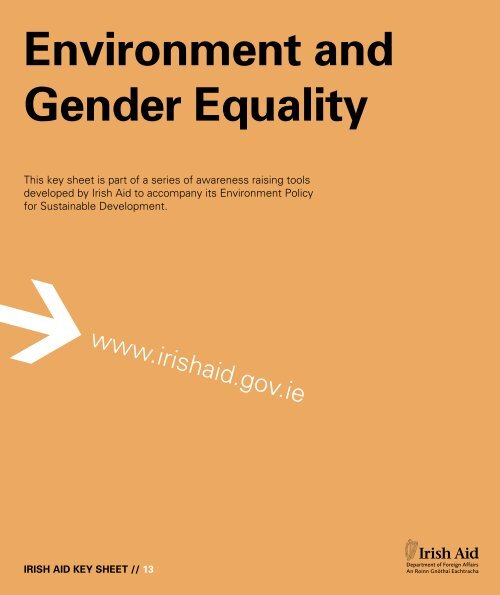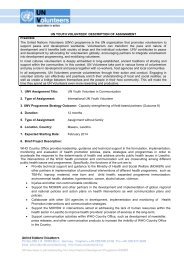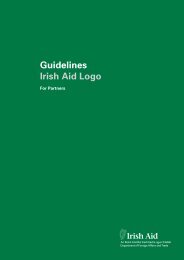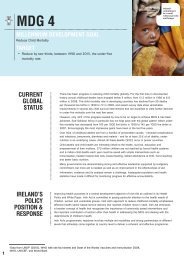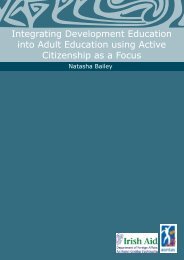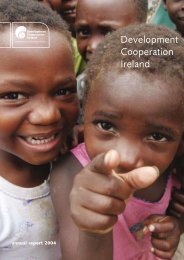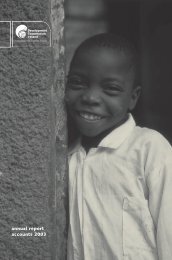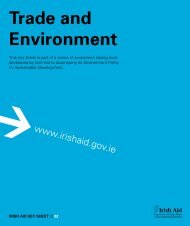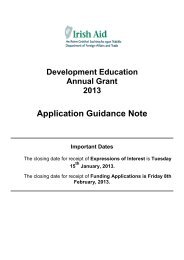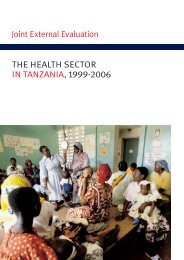Download PDF (347KB) - Irish Aid
Download PDF (347KB) - Irish Aid
Download PDF (347KB) - Irish Aid
- No tags were found...
Create successful ePaper yourself
Turn your PDF publications into a flip-book with our unique Google optimized e-Paper software.
Environment andGender EqualityThis key sheet is part of a series of awareness raising toolsdeveloped by <strong>Irish</strong> <strong>Aid</strong> to accompany its Environment Policyfor Sustainable Development.IRISH AID Key Sheet // 13
Firewood distribution in a camp for Rwandanrefugees. Photo: Chris Sattlberger/Panos
2. Women, Environmentand DevelopmentPoor men and women are increasingly recognised ascaretakers of the environment . Women are particularly relianton the environment to meet their basic needs and play anessential role as managers (i.e. use and control) of naturalresources. Women are responsible for reproduction andproduction in the household and for water and energy needs,placing them in direct contact with the natural environment ona daily basis. Women therefore rely more heavily on naturalresources than men as they have fewer alternative sourcesof livelihood. Men can migrate to urban centres to look forwork and diversify into labouring or small business, whilewomen often must remain at home to fulfil responsibilitiessuch as caring for the family, sick and elderly. They rely on theresources available to them locally to fulfil these needs. Theytend to grow crops and keep small animals for consumptionand rarely engage in cash cropping or market orientatedproduction as they are too occupied meeting day to day needs.‘Throughout Africa, women are the primarycaretakers, holding significant responsibilityfor tilling the land and feeding their families. As aresult, they are often the first to become aware ofenvironmental damage as resources become scarceand incapable of sustaining their families’.Wangari Maathai – Nobel Lecture, Oslo,December 10, 2004Although women are highly reliant on their local environmentfor their livelihoods, they frequently lack ownership anddecision-making power over the natural resources on whichthey depend. These factors limit women’s potential to climbout of poverty, makes them very vulnerable to environmentalchange or degradation, and increases and perpetuatesinequality.3. Environmental changeand gender equalityPopulation growth, changing climatic conditions and increasingpressure on resources leads to environmental degradation.The result is scarcity of resources and declining resourcequality with knock-on effects on livelihoods. Water and fuel World Resources 2005. The wealth of the Poor: Managing ecosystems tofight poverty. Online at http://population.wri.org/worldresources2005-pub-4073.htmlwood are vital natural resources and their collection and use inthe household is largely the responsibility of women and girls.As water supplies and other natural resources becomedepleted due to over-exploitation, the amount of timeand energy women and girls spend on household dutiesdramatically increases. Women have to travel further to collectwater and fuel, requiring much of their valuable time. Girlsmay be taken out of school to assist with these tasks andbecause they cannot complete their education their futureprospects are limited. Venturing into isolated areas in searchof resources may also expose them to the added risk ofgender based violence and it’s resulting consequences.According to the World Health Organisation, the dailyenergy requirement to carry water may consume one thirdof a woman’s calorie intake. Environmental degradationentrenches the disadvantaged position of women and girlsin relation to men as they have less time and less energy forother productive activities, and gender stereotypical roles andinequality are perpetuated.Exposure to industrial and agricultural chemicals and organicpollutants through daily farming has a profound impact onwomen’s health; it affects their reproductive health, leadingto complications in childbirth and pregnancy. This furtherincapacitates them, increasing their difficulties in securing theirlivelihood and in participating in development processes.Urbanisation as a result of environmental degradation also hasdisproportionately negative effects on women. Due to theircaring and domestic roles, they are exposed more readily tochemicals and pollutants found in water sources in cities. Overcrowdingin slums results in the added risk of air and smokepollution from fires within small dwellings. Minimal security ofthese dwellings means their safety and health is compromised,placing them at risk of Gender Based Violence.4. Access todecision-making andrepresentationA related knock-on effect of environmental degradation is thatwomen have less time for participation in community affairsand are often not consulted on key environmental programmesand plans. Women should be equally involved in designing andmanaging water and sanitation facilities and other communalnatural resources.
For example, as the main users of wells and water pumps,women should have real input into the location of waterpoints and in their management. Both women and men canbe trained in the maintenance of pumps and given equalresponsibility for collecting and managing water use fees.While household hygiene tends to be the responsibility ofwomen, training men as well as women in this role ensuresthat both women and men understand and take responsibilityfor the links between sanitation and safe drinking water andthe protection of their own and their families’ health.Care should always be taken to ensure that genderstereotypical roles are not reinforced, that women’swork burden is not increased and that the benefits of andresponsibility for water management is enjoyed equally bymen and women.The importance of adequate sanitation facilities in increasinggirls’ attendance at school is well documented (see below).Ethiopian teenage girls hardest hit by lackof latrinesA study in Benishangul Gumuz, a remote region of Ethiopia,has shown that teenage girls were hit the hardest by alack of decent school sanitation. In these areas only 4% ofthe population has access to sanitation. Many schools hadno toilets and in others, students had to share one latrinebetween 325 other pupils. Some girls interviewed said thatthey could not be seen to go to a latrine in their school,especially on menstruation days. Many go home and donot return, and many more drop out of school completely.Many pupils said they were unable to be clean and hygienicas they didn’t have water in their schools either.Source: Water<strong>Aid</strong>, Ethiopia 30 Aug 2005Failure to take into account women’s perspectives andtheir interaction with the environment can lead to policiesthat further marginalise women and even criminalise theirbehaviour. Policies to protect against deforestation arean example of this, where local communities are refusedpermission to use forests to produce charcoal, which is often avital component of income generating and livelihood strategiesfor women during lean periods.In poor communities wood or dung is collected as fuel bywomen and and burned for cooking, warming water and as asource of heat. Women are frequently blamed for deforestationdue to their fuel wood collecting activities while more oftenthan not it is the cutting of wood for construction materialsand for sale (primarily male activities) that is the primary cause.Women tend to collect dead wood which burns more easily;they only cut green wood if they have no alternative.By drawing women and men into environmental managementand understanding their different needs and perspectives,policies can be developed that meet the needs of entirecommunities without compromising the sustainability of theresource base.Women particularly need specific and official channels ofsupport to ensure that they can access and participate indecision-making related to the environment and must beinvolved in management on a burden-sharing basis with men.Environmental Sound Technologies (ESTs) arebeing introduced to reduce energy demands andsafeguard health. Improved stoves burn fuel moreefficiently and require less fuel. This has benefits forwomen as it reduces the amount of fuel wood they needto collect and it reduces the amount of smoke released,thereby reducing indoor pollution and respiratory disease.Women’s voices must be taken into account whendesigning stoves, as in the past stoves were designedwhich did not take traditional foods and cooking practicesinto account and as a result were not adopted by womendespite their energy saving potential.5. Control over and accessto resourcesAccess to resources is a critical factor affecting povertyreduction and income generation. Poor men and women tendto have very insecure access to natural resources despitetheir reliance on them for their livelihoods. Redistribution ofland by government, resettlement and the sale of traditionallyheld lands to commercial enterprises can leave poor men andwomen landless or reliant on more marginal lands. Tenuresecurity encourages farmers to invest in their land through soilconservation, fertilisation and irrigation and it can help them toaccess credit using the land as collateral. However, womentraditionally do not have access to technical inputs and advisethat increase productivity and some actors may erroneouslynot consider them to be ‘farmers’ or to be economically active.The World Bank estimates that if women in sub-Saharan Africahad equal access to agricultural inputs, the total agriculturaloutput for the region could increase by up to 20 percent . Gender Equality and the Millennium Development Goals, Gender andDevelopment Group, World Bank, April 2003.
The issues of access to and control over resources affects menand women differently. In most societies, land is traditionallythe property of men and is handed down from father to son.In many cases women cannot own or inherit land, even ifthey are responsible for tilling the land and growing crops.This can mean that women do not have rights to the incomederived from the crops they have grown and it poses seriousproblems if a woman’s husband dies and his family inherits theland, leaving her and her children destitute. Women may alsonot have a say in how the land is used and what use is madeof crops despite their role in producing these crops. ManyAfrican countries are engaged in land certification schemeswhere governments are giving farmers use rights to their land.Donor agencies are working with governments to ensure thathusbands and wives co-sign land use certificates and that theuse rights can be inherited by and assigned to women. Changing land use rights in Ethiopia 4Regional governments in Ethiopia, including Tigray where<strong>Irish</strong> <strong>Aid</strong> is active, are currently writing and implementingnew land laws which aim to increase tenure security forfarmers. Land certificates assign use rights to farmersfor the land they have traditionally cultivated but which isofficially state land. In most cases the legislation requiresthat both the husband and wife sign the land use certificateto signify their joint rights. In addition, women headedhouseholds can receive a certificate in the woman’s nameand women can inherit certificates on the death of theirhusband. Careful monitoring will be needed to ensure thatthe certificates work as planned and protect the rights ofpoor men and women to their land.As land and resource use laws change, women need to beinformed of their new rights. Agencies need to rememberthat women may be unable to attend public meetings on theseissues for social reasons or be unable to travel due to familyresponsibilities. This lack of exposure to information and thehigh levels of illiteracy among women mean that they tendto be less well informed about their rights than men. Thereis also a tendency among aid agencies to assume that menwill pass on the information to their wives, which may notalways be the case. Initiatives to educate women and menabout their rights must be tailored around the daily roles andresponsibilities of men and women, and where necessary,tailored to facilitate women’s participation.Defending women’s land rights in KenyaThe Federation of Women Lawyers in Kenya (FIDA) issupported by <strong>Irish</strong> AId to provide free advice to women ontheir land rights. Individual women can bring their casesto FIDA and receive legal support to fight their case. Inaddition, FIDA is working closely with the government toensure that gender issues are mainstreamed into the newland policy which is being developed through a consultativeand collaborative process.Poor men and women are highly dependant on CommonProperty Resources (CPRs) such as forests, pastureland,fishing grounds and wetlands for their livelihoods. Thesecommonly owned resources provide poor men and womenwith wild foods (particularly important as a coping strategyduring food shortages) medicinal plants and constructionmaterials. CPRs are managed by traditional, socially acceptedrules, which may or may not ensure equity of access andsustainable use (matriarchal versus patriarchal systems). Whenthese rules break down due to pressures from populationgrowth and development, resources can become scarce anddegraded. Women are especially dependent on CPRs as theyoften don’t have access to formally recognised farming lands.As CPRs become degraded or are converted to other uses(e.g. wetlands reclaimed for intensive farming, forests clearedfor roads) women lose a valuable source of food and income.6. Vulnerability andenvironmental securityPoor households are vulnerable to environmental shocks,including drought, floods, cyclones and outbreaks of disease.Women headed households tend to be the most vulnerable ina community, and are at a greater disadvantage when disasterstrikes. Women tend to have less diversified opportunitiesfor income generation than men and are wholly reliant on thenatural resource base pre and post disaster. In situations ofmass population movement, such as displaced and refugeesettings, women are often wrongly blamed for destruction oftheir new surroundings as they continue to collect wood andother resources for their family’s survival. <strong>Aid</strong> organisationsmust be encouraged to address the gendered responsibilitiesof members of these populations by assisting men and womento find environmentally sound ways to meet their requirements Ongoing work as part of the <strong>Irish</strong> <strong>Aid</strong>-Ethiopia Operational ResearchProgramme in SNNPR and Tigray regions.Women are also more likely to have fewer assets than men,especially physical assets that can be sold in times of stress.Limited access to credit and market-based activities mean that
women have limited opportunities to reduce their vulnerabilityto natural shocks such as drought, land degradation andflooding.Vulnerability to flooding in MozambiquePoor men and women cultivate land in high risk, fertileflood plains along the coast in Mozambique. The floodplainsare a common property resource and are accessible towomen who do not own their own land. The 2000 and2001 floods meant many men and women lost their livesand their livelihoods as they refused to heed warningsto evacuate. Women in particular did not leave, as theyfeared they would lose their claim to their land and theircrops. When the floods receded they returned to cultivatethe same areas even though they had been resettledelsewhere. This is because they had limited access to landnear their new homes and the land in the floodplains wasmore fertile.Environmental disasters are not gender neutral . Womenand children are particularly affected by disasters, accountingfor more than seventy five percent of displaced persons. Inaddition to the general effects of natural disasters and lack ofhealth care, women are vulnerable to reproductive and sexualhealth problems, and increased rates of sexual and domesticviolence which require specific response interventions.Women’s vulnerability increases when they lose theirhusbands and are forced to provide for their families on theirown and struggle for recognition in patriarchal systems. Inaddition, women are the primary carers of those affected bydisasters, increasing their emotional and physical workload. Women worst affected by cyclones in BangladeshWomen suffered most following the cyclone and floodsin Bangladesh in 1991. Among women aged 20-44 thedeath rate was 71 per 1000, compared to 15 per 1000for men. Women were left at home by their husbands tocare for children and protect property and needed to havepermission from their husbands to evacuate. In addition,saris restricted their movement and women were weakerthan men due to malnutrition. Finally, the lack of facilitiesand privacy in cyclone shelters dissuaded women fromusing them. 7 BRIDGE, Environment Policies and Gender Equality. For more information see ‘Gender Based Violence; a failure to protect. AChallenge to Action’. Joint Consortium of <strong>Irish</strong> Human Rights, Humanitarianand Development Agencies and Development Cooperation Ireland. 2005.Online at http://www.dci.gov.ie/uploads/Gender%20Based%20Violence%20study.pdf See BRIDGE report number 26: Background Paper on Gender Issues inBangladesh, S. Baden, A.M> Goetz, C. Green and M. Guhathakurta. ODA,August 2004.7. Positive actions tomaximise links betweenenvironment and genderThere are many opportunities in the <strong>Irish</strong> <strong>Aid</strong> programmeto address the linkages between environment and genderequality. Both issues are addressed through mainstreamingtraining and are further elaborated in the <strong>Irish</strong> <strong>Aid</strong>mainstreaming strategy.To be effective, strategies to decrease poverty and preservethe environment need to take into account the disparitiesbetween men and women’s access to resources and livelihoodopportunities. Opportunities to mainstream environment and gender equalityand to enhance synergies between them include the following:> Raise awareness of the impact of environmentaldegradation and environmental risk on women’s livelihoods,health and safety.> Ensure women and men are equally involved in decisionmaking for environmental policy and planning.> Identify opportunities to mainstream environment andgender equality in Poverty Reduction Papers (PRSPs) andCountry Strategy Papers (CSPs), sector strategies and areabasedprogrammes.> Identify win-win activities for environment and genderequality e.g. natural resources managed equally by menand women in communities; livelihood diversification tomeet men’s and women’s needs; support strategies toempower women to engage equally with men in decisionmaking related to the environment and natural resources.> Promote and support women’s rights to access, use andownership of land and other natural resources.> Improve women’s access to credit so that they candiversify their income generating activities and reduce theirdependency on natural resources.> Support research into understanding the coping strategiesof poor women and men and identifying ways to protect thenatural resources on which they depend in times of stress.> Ensure gender sensitive approaches are used in responding tonatural disasters and in post-conflict and recovery situations.> Ensure that agricultural extension services take account ofgender roles and responsibilities in target communities andtailor appropriate training and inputs at both women and men.> Identify opportunities to provide specific support to addressinequalities in the way that natural resources are used,owned and managed by men and women. Poverty-Environment Gender Linkages. OECD – DAC, 2001.
References and useful websitesGender Equality Policy, Development Cooperation Ireland, September 2004.http://www.dci.gov.ie/Uploads/Gender%20Equality%20Policy.pdfGender Based Violence; a failure to protect - A Challenge to Action. Joint Consortium of <strong>Irish</strong> Human Rights, Humanitarian andDevelopment Agencies and Development Cooperation Ireland. 2005. http://www.dci.gov.ie/uploads/Gender%20Based%20Violence%20study.pdfBRIDGE - Development and Genderhttp://www.bridge.ids.ac.uk/Environment Policies and Gender Equality BRIDGEhttp://www.bridge.ids.ac.uk/dgb1.htmlGlobal Development Research Centre – Gender and environment resourceshttp://www.gdrc.org/gender/gender-envi.htmlFood and Agriculture Organisation – gender and food security / environmenthttp://www.fao.org/Gender/en/env-e.htmInternational Institute for Environment and Development (IIED)Gender issues are addressed under Sustainable Agriculture, Biodiversity and Livelihoods and Forestry and Land Use. www.iied.orgGender and Health in Disasters, World Health Organisation, July 2002http://www.who.int/gender/other_health/en/genderdisasters.pdfAssociation for Women’s Rights in Development (AWID)http://www.awid.org/index.phpGender and Disaster Network (GDN)http://online.northumbria.ac.uk/geography_research/gdn/Women, Disaster Reduction and Sustainable Development. UNISDR 2002http://www.unisdr.org/eng/risk-reduction/gender/Women,%20disaster%20reduction%20and%20SD.pdfWorldwide Fund for Nature. Research and activities in the area of Population, Health and Environment.http://www.panda.org/about_wwf/what_we_do/policy/people_environment/pop_health_environment/index.cfm<strong>Irish</strong> <strong>Aid</strong> Environment Policy for Sustainable Developmenthttp://www.irishaid.gov.ie/development_environment.asp.htm<strong>Irish</strong> <strong>Aid</strong> mainstreaming Strategyhttp://www.irishaid.gov.ie/uploads/mainstreaming%20strategy%20finaql%202007.docAll photography: Panos


